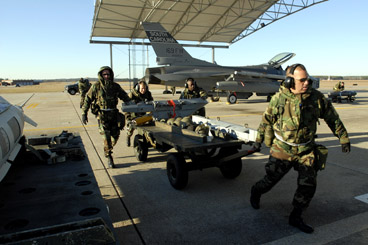A Defense Bill—Finally
The much-delayed 2008 defense authorization bill that was finally enacted in January contains initiatives to raise military pay, enhance support for wounded warriors, and strengthen entitlements for disabled military retirees and surviving spouses, among other things.
Within the $696 billion defense policy bill, the generalized pay and benefit gains for service members, retirees, and surviving spouses include:
Pay raises. Service members received a 3.5 percent pay raise effective Jan. 1. The boost was delayed for a brief period while the White House and Congress wrangled over deletion of a single item in the bill. However, Bush directed the Defense Department to apply the full increase retroactively. However, Congress declined a chance to support a House-backed plan to continue to set military raises in 2009 and beyond a half percent point above private sector wage growth.
 |
The bill has something for active, Guard, and Reserve airmen. (USAF photo by MSgt. Marvin R. Preston) |
Adjustments in leave. Starting next Oct. 1, a service member will be able to carry up to 75 days of leave into a new fiscal year. The current limit is 60 days. This authority will expire Dec. 31, 2010 unless extended. Also, enlisted members who accumulate more than 120 days of unused leave will be able to sell back, on a one-time basis, up to 30 days of leave in excess of 120 days. Also, five days of rest and recuperation leave will be added to the 15 now allowed when an arduous overseas tour lasts longer than 12 months.
Expansion of CRSC. More than 13,000 “Chapter 61” disabled retirees with combat-related disabilities will be eligible to receive Combat-Related Special Compensation in addition to disability retirement. Chapter 61 retirees were forced to retired before 20 years because of combat wounds, training injuries, or other combat-related conditions. CRSC for them will be set like retired pay, at 2.5 percent of basic pay for each year served. It will be paid on top of disability compensation, thus ending for combat-injured veterans the ban on “concurrent receipt.” CRSC payments would be paid retroactive to Jan. 1, 2008.
IU retro pay. Thousands of retirees with 20 or more years of service and rated “IU,” or unemployable, by Veterans Affairs will become eligible for full Concurrent Retirement and Disability Payment back to Jan. 1, 2005. The lump-sum retroactive payments won’t be made, however, until Oct. 1, 2008. IU retirees draw disability at the 100 percent level only because they are unemployable. Their actual disabilities are rated 60 to 90 percent disabling. IU retirees were excluded from full concurrent receipt payments when they began three years ago. Congress agreed to pay full CRDP to IU retirees back to January 2005.
Survivors’ indemnity. Survivors of disabled retirees see their Survivor Benefit Plan annuities reduced each month by the amount they draw in tax-free Dependency and Indemnity Compensation (DIC) from the VA. DIC is payable if the member died while on active duty or if retirees died from service-related conditions. Congress has voted to begin to eliminate this offset starting Oct. 1, 2008, by paying a $50-a-month “indemnity allowance” to survivors affected by the SBP-DIC offset. It increases every year by $10 until it reaches $100 a month in 2013. Due to high cost, Congress declined to restore full SPB to DIC widows.
Early reserve retirement. For Reservists and Guardsmen, the bill lowers the age 60 start date for retirement by three months for each 90 days served in support of an operational contingency. The change applies only to deployments after the date of the bill’s enactment. Congress said it had no money to make the provision apply retroactively to the thousands who have deployed to Iraq and Afghanistan since 2001. Rep. Joe Wilson (R-S.C.) introduced the National Guardsmen and Reservists Parity for Patriots Act (HR 4930) a bill to require that early retirement benefit be applied to contingency operations since 9/11.
Reserve education benefits. Reserve personnel no longer have to remain in drill status to use benefits earned through the Reserve Educational Assistance Program, available for deployments of 90 days or longer. REAP was established by Congress three years ago to boost educational assistance to reserve component members called to active duty in response to war or national emergencies. To use these benefits, however, reservists needed to remain in drill status. Now they will have 10 years to use benefits after separating. Those who already have left reserve status will be able to rejoin and reclaim previously earned educational benefits and use them for 10 years following their next separation.
 |
Wounded warriors get special legislative attention. (USAF photo by MSgt. John R. Nimmo Sr.) |
“Wounded Warrior” Matters
Within the authorization bill, a special “Wounded Warrior” section contained a number of specific orders that aim to improve care for military members suffering from injury.
- New contact center. Establishment of a Wounded Warrior Resource Center where service members, their families and primary caregivers would have a single point of contact to report deficiencies in facilities, to get assistance on health services, or to obtain benefits information.
- Other centers. Establishment of separate centers for excellence for diagnosis, treatment, and prevention of traumatic brain injury; mental health conditions; and eye injuries.
- Comprehensive policy. Development of a comprehensive policy by July 1, 2008, on care, management and transition of recovering service members. Rather than set standards on maximum case loads for recovery coordinators and patient managers, Congress orders DOD and the services to set their own uniform standards but to report to Congress every 90 days on whether they are being met.
- Evaluations. Combat veterans to receive mental health evaluations within 30 days of requesting one.
- Dental care. Veterans with service-connected dental conditions to have 180 days, rather than 90 days, after being released from active duty to apply for VA dental benefits.
- Increased leave. Those providing care for seriously injured service members must be allowed up to 26 weeks of leave, rather than 12, under the Family Medical Leave Act.
Task Force Seeks New Fees
After a year’s study, the Task Force on the Future of Military Health Care in December delivered to Congress a final report calling for increases in Tricare fees, co-pays, and deductibles for retirees and their families.
The aim is to slow Tricare cost growth. It would also be “fairer” to taxpayers, the task force said, given that fees have been frozen since first set in 1996 but indexing and inflation have driven up benefits.
Co-chaired by Gen. John D. W. Corley, commander of Air Combat Command, and economist Gail R. Wilensky, the task force recommended other sweeping changes to the business of military health care.
Congress is expected to hold hearings on the task force recommendations this spring. Seven of 14 task force members were civilian compensation experts. The other members were active or retired general officers. They included retired Air Force Gen. Richard B. Myers—the former Chairman of the Joint Chiefs—and Lt. Gen. James G. Roudebush, Air Force surgeon general.
How Tricare Costs Would Rise
While the report made broad recommendations, the political lightning rod is its call for raising retiree cost shares. Here’s a summary of the fee recommendations:
- Tricare Prime. The annual enrollment fee of $460 for families and $230 for individuals should be raised incrementally over four years. New fee levels would vary based on level of retired pay. A retiree drawing less than $20,000 would pay $570 the first year and $900 by 2011 for family coverage. Retirees with retired pay of $20,000 to $40,000 would pay $640 in 2008 and $1,190 by 2011. Those with annuities of more than $40,000 would pay $780 the first year and $1,750 by 2011. After fees are reset, they would be indexed for inflation.
- Tricare Standard. Deductibles for Standard would double to an average of $600 a year for families and $300 for individuals, up from $300 and $150, respectively. Standard deductible amounts, as with Prime enrollment fees, would be tiered, based on the level of retired pay. Under-65 retirees and their families using Standard also would begin paying $120 a year to enroll. This fee would be increased annually to keep pace with the cost of civilian-provided care to beneficiaries.
- Tricare for Life. Service elderly would pay a $120 annual enrollment fee for TFL coverage. Wilensky said this isn’t a cost-savings move but is intended “to foster personal accountability and to be consistent with the task force philosophy that military retiree health care should be very generous but not free.”
- Tricare Open Season. The task force would ban under-65 retirees and their families from shifting between Tricare Prime and Tricare Standard options except during a new “open season” period to be held annually.
- Pharmacy co-pays. Under the Tricare retail network, co-pays for drugs would be raised to a range of $15 to $45, up from $3 to $22. Many mail-order drugs would be free, to encourage use of this more efficient point-of-service for pharmacy benefit users.